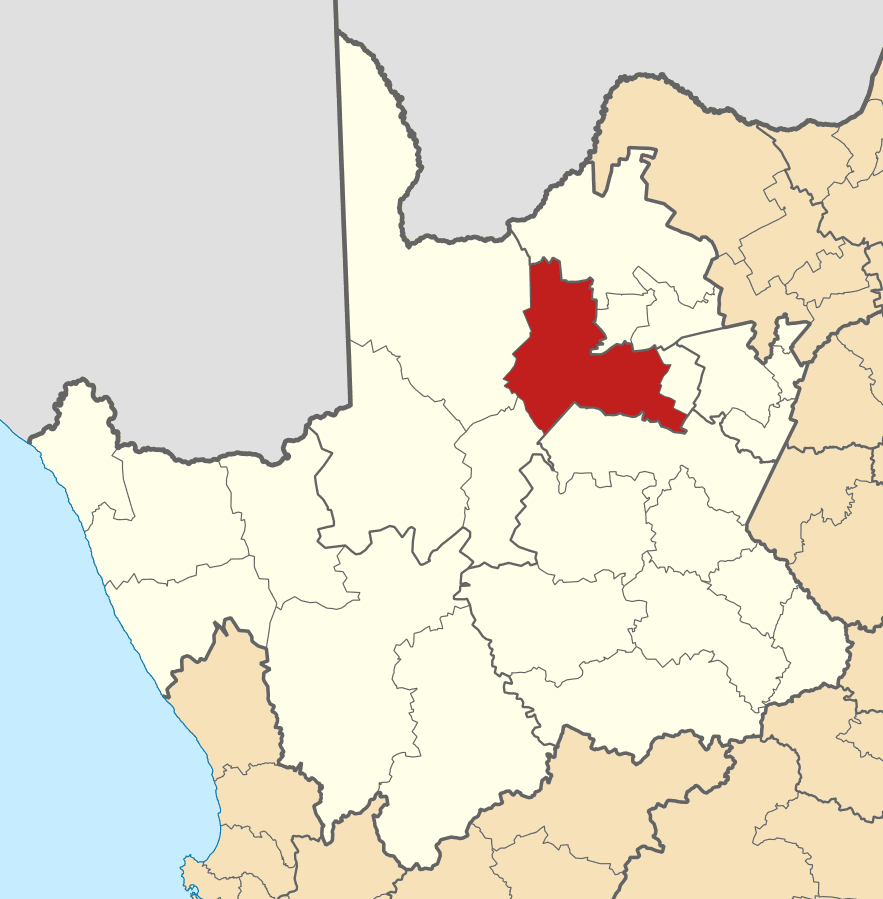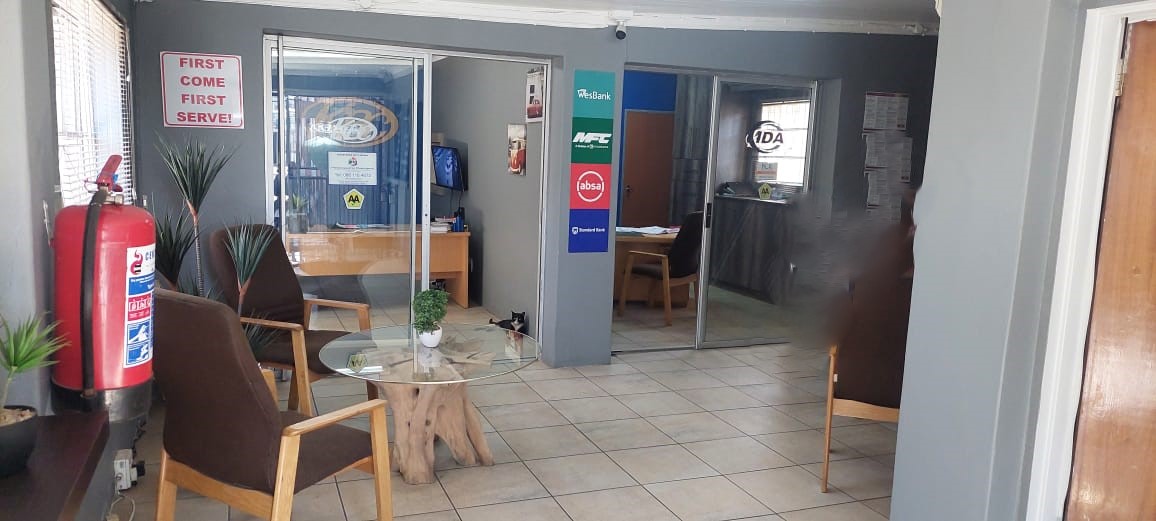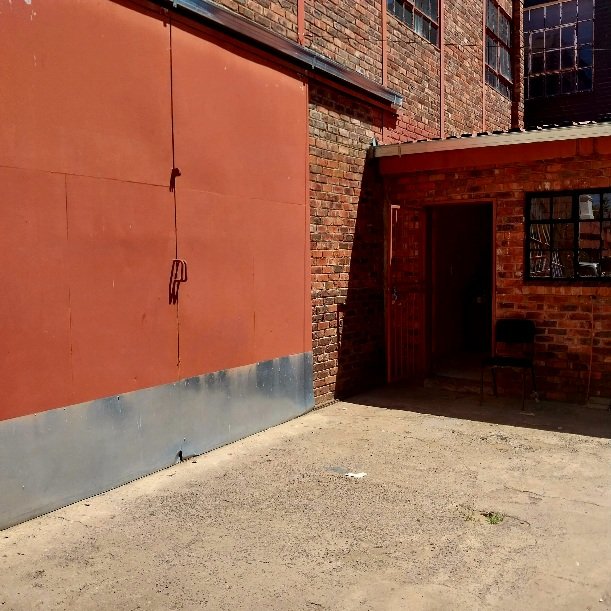The Northern Cape (Afrikaans: Noord-Kaap; Xhosa: eMntla-Koloni; Tswana: Kapa Bokone) is the largest and most sparsely populated province of South Africa. It was created in 1994 when the Cape Province was split up. Its capital is Kimberley. It includes the Kalahari Gemsbok National Park, part of the Kgalagadi Transfrontier Park and an international park shared with Botswana. It also includes the Augrabies Falls and the diamond mining regions in Kimberley and Alexander Bay.
The Namaqualand region in the west is famous for its Namaqualand daisies. The southern towns of De Aar and Colesberg found within the Great Karoo are major transport nodes between Johannesburg, Cape Town and Port Elizabeth. Kuruman can be found in the north-east and is known as a mission station. It is also well known for its artesian spring and Eye of Kuruman. The Orange River flows through the province of Northern Cape, forming the borders with the Free State in the southeast and with Namibia to the northwest. The river is also used to irrigate the many vineyards in the arid region near Upington.
Native speakers of Afrikaans comprise a higher percentage of the population in the Northern Cape than in any other province. The Northern Cape’s four official languages are Afrikaans, Tswana, Xhosa, and English. Minorities speak the other official languages of South Africa and a few people speak indigenous languages such as Nama and Khwe.
Quick Facts
- Area: 372,889 km2
- Population Est: 1,303,047
- Density: 3.1/km2
- Languages:
- Afrikaans (53.8%)
- Tswana (33.1%)
- Xhosa (5.3%)
- English (3.4%)
- Capital: Kimberley

Climate
Economy
Demographics
Government
Political History
Climate
Mostly arid to semiarid, few areas in the province receive more than 400 mm (16 in) of rainfall per annum and the average annual rainfall over the province is 202 mm (8.0 in). Rainfall generally increases from west to east from a minimum average of 20 mm (0.79 in) to a maximum of 540 mm (21 in) per year. The west experiences most rainfall in winter, while the east receives most of its moisture from late summer thunderstorms.
Many areas experience extreme heat, with the hottest temperatures in South Africa measured along the Namibian border. Summers maximums are generally 30 °C (86 °F) or higher, sometimes higher than 40 °C (104 °F). Winters are usually frosty and clear, with southern areas sometimes becoming bitterly cold, such as Sutherland, which often receives snow and temperatures occasionally drop below the −10 °C (14 °F) mark.
- Kimberley averages: January maximum: 33 °C (91 °F) (min: 18 °C (64 °F)), June maximum: 18 °C (64 °F) (min: 3 °C (37 °F)), annual precipitation: 414 mm (16.3 in)
- Springbok averages: January maximum: 30 °C (86 °F) (min: 15 °C (59 °F)), July maximum: 17 °C (63 °F) (min: 7 °C (45 °F)), annual precipitation: 195 mm (7.7 in)
- Sutherland averages: January maximum: 27 °C (81 °F) (min: 9 °C (48 °F)), July maximum: 13 °C (55 °F) (min: −3 °C (27 °F)), annual precipitation: 237 mm (9.3 in)
Economy
The Northern Cape is South Africa’s largest province, and distances between towns are enormous due to its sparse population. Its size is just shy of the size of the American state of Montana and slightly larger than that of Germany. The province is dominated by the Karoo Basin and consists mostly of sedimentary rocks and some dolerite intrusions. The south and south-east of the province is high-lying, 1,200–1,900 metres (3,900–6,200 ft), in the Roggeveld and Nuweveld districts.
The west coast is dominated by the Namaqualand region, famous for its spring flowers. This area is hilly to mountainous and consists of granites and metamorphic rocks. The central areas are generally flat with interspersed salt pans. Kimberlite intrusions punctuate the Karoo rocks, giving the province its most precious natural resource, diamonds. The north is primarily Kalahari Desert, characterised by parallel red sand dunes and acacia tree dry savanna.
Northern Cape has a shoreline in the west on the South Atlantic Ocean. It borders the following areas of Namibia and Botswana:
- ǁKaras Region, Namibia – northwest
- Hardap Region, Namibia – far northwest
- Kgalagadi District, Botswana – north
- North West – northeast
- Free State – east
- Eastern Cape – southeast
- Western Cape – south and southwest
Demographics
About 68% of the population are first-language Afrikaans speakers, other primary languages being Setswana, Xhosa and English. To the extent that apartheid-era population classification persists, the majority of the Northern Cape population is characterised as Coloured.
People who self-identify as San people, some of whom retain distinct indigenous cultural elements such as Khoisan languages, but no longer subsist by hunting and gathering, live in the Northern Cape.
Government
The provincial government consists of a premier, an executive council of ten ministers, and a legislature. The provincial assembly and premier are elected for five-year terms, or until the next national election. Political parties are awarded assembly seats based on the percentage of votes each party receives in the province during the national elections. The assembly elects a premier, who then appoints the members of the executive council. The premier of the Northern Cape as of 2019 is Zamani Saul of the African National Congress.
Political History
The politics of the Northern Cape are dominated by the African National Congress (ANC), but their position has not been as strong as in the other provinces. Initially, no party had an absolute majority. In 1994 the ANC’s Manne Dipico became the first Premier of the Northern Cape after Ethne Papenfus, the sole elected representative of the Democratic Party (DP), voted with the ANC. In return, she was elected speaker of the legislature.
The ANC increased its voter share in later elections and has remained firmly in charge of the province after 1999. Dipuo Peters replaced Dipico as Premier in 2004. The official opposition in the Northern Cape after the 2004 elections was the Democratic Alliance, receiving 11% of the vote in the provincial ballot. The opposition’s hopes of unseating the ANC has not had any success, even with the Congress of the People (COPE), a splinter party from the ANC, helping to split the vote in the election of 22 April 2009. Hazel Jenkins became Premier following the election, and COPE became the official opposition. Jenkins was later replaced by Sylvia Lucas in 2013.
The 2014 election saw the ANC returned to power once again with an increased mandate, while DA once again became the official opposition, after the collapse of COPE. The newly formed Economic Freedom Fighters (EFF) also entered the legislature for the first time. Sylvia Lucas was re-elected to her first full term.
In the 2019 election, the Northern Cape was considered competitive. The opposition DA planned on taking over the province. The ANC returned as the majority party but the party’s support had dropped. The DA was once again the official opposition with an increased seat total. The EFF made gains, while the Freedom Front Plus (FF+) won a seat in the legislature for the first time since 2004.
5 days ago
5 days ago
5 days ago
5 days ago
5 days ago
6 days ago
6 days ago
6 days ago
6 days ago
6 days ago



















